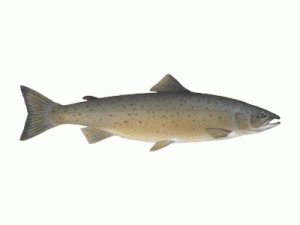Connecticut’s Department of Energy & Environmental Protection (DEEP) has begun autumn stockings of broodstock Atlantic salmon.
Biologists are releasing salmon into a number of Connecticut waterways including the Naugatuck River, Shetucket River, Mount Tom Pond, and Crystal Lake (Ellington).
“Atlantic salmon are renowned for their size, beauty and fighting ability,” said Peter Aarrestad, Director of DEEP’s Inland Fisheries Division. “The Atlantic salmon recreational fishery has become quite popular, and catching one of these large leapers provides a thrilling experience for anglers.”
The Atlantic salmon being stocked in Connecticut were raised in the Kensington State Fish Hatchery and are the progeny of sea-run fish that returned to the Connecticut River.
The broodstock Atlantic salmon being released range in weight from 2-6 pounds each. In early October, approximately 400 additional fish in the same size range will be available for stocking.
DEEP expects several hundred additional salmon from the Kensington Hatchery will be available for stocking in November. These fish will range in weight from 3 to 15 pounds each.
Atlantic salmon broodstock stocked in the Shetucket and Naugatuck Rivers are typically released into three designated Atlantic Salmon Broodstock Areas:
* Between Scotland Dam (Scotland) and Occum Dam (Norwich) on the Shetucket River
* The “Campville Section” of the upper Naugatuck River from Route 118 downstream to the Thomaston Flood Control Dam (Litchfield-Thomaston)
* The “Beacon Falls Section” of the lower Naugatuck from Prospect Street (Naugatuck) downstream to Pines Bridge Road (Route 42 bridge, Beacon Falls).
Anglers are allowed to fish for salmon in the Naugatuck River from the confluence of the East and West Branches (Torrington) downstream to the Housatonic River (Derby). Anglers may also fish for Atlantic salmon in the Housatonic River downstream of Derby Dam.
On the Shetucket River, anglers can fish for salmon downstream from the Scotland Dam (Windham) to the Water Street Bridge in Norwich (the first bridge upstream of Norwich Harbor).
In 2007 DEEP began stocking selected lakes with broodstock Atlantic salmon. This fall, Mount Tom Pond and Crystal Lake are again being stocked.
Anglers may also very occasionally catch salmon that have held over from previous stockings of Beach Pond, Long Pond (Ledyard/North Stonington), Mashapaug Lake and Nells Rock Reservoir (Shelton).
The regulations for broodstock Atlantic salmon released into lakes and ponds are different from the regulations for salmon in the Naugatuck, Housatonic and Shetucket Rivers.
In each lake, the regulations for methods, seasons and minimum lengths for salmon are the same as for trout in that specific water body but the daily creel limit is one salmon per day.
The specific regulations for salmon fishing in lakes that have been stocked with Atlantic salmon can be found in the 2013 Connecticut Angler’s Guide. The regulations for broodstock Atlantic salmon stocked into lakes and ponds will also be posted at each water body. Anglers can also contact DEEP’s Inland Fisheries Division (860-424-FISH) for more information.
All other regulations, including those for broodstock salmon in the Naugatuck, Housatonic and Shetucket Rivers, can also be found in the 2013 Connecticut Angler’s Guide, found online at www.ct.gov/deep/anglersguide.
Print versions of the guides are available from many Town Clerks and bait & tackle stores, or by contacting DEEP’s Inland Fisheries Division (860-424-FISH).
Additional fishing and fisheries related information, including the Weekly Fishing Report, can be found on the DEEP Fisheries web pages at www.ct.gov/deep/fishing and on the Fisheries and Wildlife Facebook page at www.facebook.com/CTFishandWildlife.
This fall, anglers will find updates on DEEP’s broodstock Atlantic salmon stockings and the fall trout stockings in the Weekly Fishing Report, on the Fisheries webpage and on the Fisheries and Wildlife social media pages.
source: Connecticut Department of Energy & Environmental Protection
